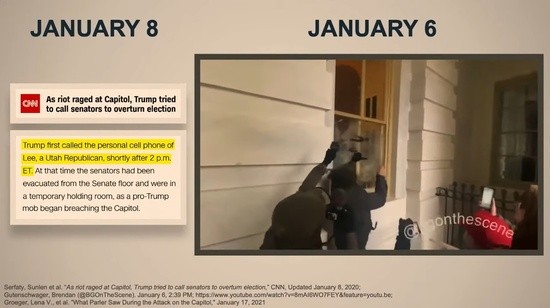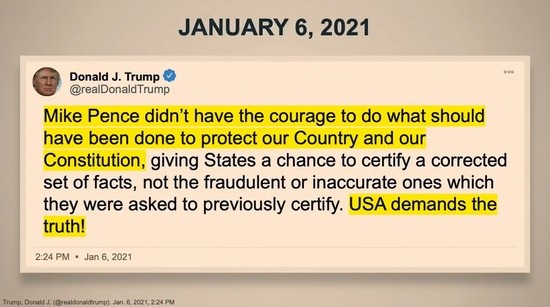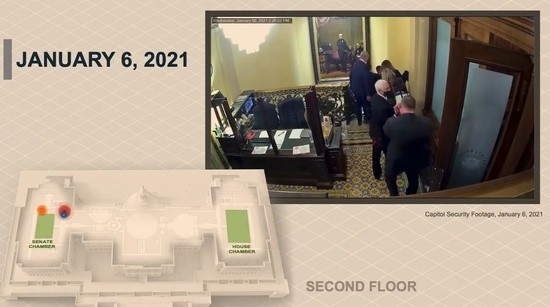In two days of presentations, the House impeachment managers laid out a case that seems more than ironclad; it seems to demand action. Starting with a chilling video of events on Jan. 6, they’ve walked the case both backward and forward to demonstrate every aspect of Donald Trump’s guilt. They’ve shown how Donald Trump groomed his supporters not to accept any outcome but a Trump victory from months before the election was held. How Trump immediately began insisting that the election was being “stolen” even as the votes were still being counted. Then how Trump exhausted every legal action, attempted to strong arm state and local officials, and attempted to leverage Mike Pence into taking unconstitutional action. Finally, deprived of everything else, Trump used the army of rabid supporters who he had inflamed with “stop the steal” and directed them at the Capitol on Jan. 6.
Perhaps the most chilling and effective portion of the whole presentation dealt with what Trump did after the assault was underway. Far from attempting to stop the attack or provide help to either Congress or the police, Trump acted to increase the peril. In particular, Trump used knowledge of Pence’s movement to inflame the crowd further, and repeatedly signaled his support for their actions.
On Friday, Trump’s legal team will present their case. Early indications are that it will be brief. Because, despite everything else that’s been revealed about Trump’s actions leading up to Jan. 6, many Republicans are once again prepared to give him a pass.
Imagine going to a trial in which the defendant is charged with multiple, monstrous crimes. Then, as the prosecutors are laying out the facts of the case—including the most compelling evidence that reveals details previously unknown to the public—looking over to see that half the jury isn’t even paying attention. One is doodling on a notepad. Another is playing a silly game designed for children. Others are snickering to each other and passing notes.
As it turns out, no imagination is required. Because that’s exactly how Republicans have treated this trial. As House managers showed how the police lines were being forced, Josh Hawley moved back into the viewing gallery to play. As they described the incredibly close call between Pence and rioters seeking to murder him, Rand Paul was doodling his next hair style. As House managers showed how Trump had constantly not just overlooked violence by his supporters, but encouraged it, Lindsey Graham, who was a House impeachment manager for the impeachment of Bill Clinton, was chortling over his chance to show disdain for the current trial.
Despite the way that Republicans have reacted, it’s clear that the House team laid out a compelling case immediately understandable not just in the Senate, but to the public.
But going into Friday, Trump’s legal team let it be known that their presentation may be as brief as three hours. Some of that time will likely be devoted to rehashing their nonsensical arguments about how the First Amendment protects calling for violence. Or pretending that Trump acted to do something, anything, to end the insurgency. But most of the reply from Bruce Castor and David Schoen is likely to be a funhouse mirror version of the House case.
It can be expected that they will show video of Democratic candidates urging their supporters to “fight” or “never give up.” It can be expected they’ll intersperse unconnected clips of violence from protests in Seattle or Portland or, based on other recent Republican ads, from any number of foreign countries. And because this presentation is going to be 100% aimed at giving Republican senators talking points on Fox News, it's an easy bet it will play heavily into existing memes around women of color. Expect to see Rep. Maxine Waters, Rep. Ilhan Omar, Rep. Alexandria Ocasio-Cortez, all saying things that Trump’s team will indicate are somehow “worse” than anything Trump said.
Expect to see random images of violence taken out of context, with Black Lives Matter marches put next to images of burning stores. Or black-suited figures identified as “antifa.” Expect to see a video, and a presentation, that leans heavily into the racist message that Fox News has already been selling for at least as long as Trump had been grooming his supporters—that BLM marchers are destructive and violent, and that Democratic officials have encouraged them in that violence. Expect to hear a claim that Vice President Kamala Harris asking for support in bailing out protesters was just putting violent extremists back on the street to commit more crimes.
Or … maybe not. Maybe they won’t do anything at all. After all, the real test this week wasn’t one of Trump’s guilt. That was clear even before the trial began, and every moment of the presentation only made the certainty and the extent of Trump’s crimes more obvious.
The real test was whether Republicans in Congress would step away from Trump and move toward doing what the nation needs to move forward. On that point, the evidence suggests that Trump’s team could use their three hours to recite recipes, or promote the next season of Hannity, or simply provide the details for the next assault on the Capitol.
House managers did a fantastic job. They left it all on the floor. No one watching could have any question about Donald Trump’s guilt. Republicans don’t have any question about Trump’s guilt.









